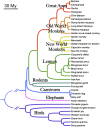The evolution of self-control
- PMID: 24753565
- PMCID: PMC4034204
- DOI: 10.1073/pnas.1323533111
The evolution of self-control
Abstract
Cognition presents evolutionary research with one of its greatest challenges. Cognitive evolution has been explained at the proximate level by shifts in absolute and relative brain volume and at the ultimate level by differences in social and dietary complexity. However, no study has integrated the experimental and phylogenetic approach at the scale required to rigorously test these explanations. Instead, previous research has largely relied on various measures of brain size as proxies for cognitive abilities. We experimentally evaluated these major evolutionary explanations by quantitatively comparing the cognitive performance of 567 individuals representing 36 species on two problem-solving tasks measuring self-control. Phylogenetic analysis revealed that absolute brain volume best predicted performance across species and accounted for considerably more variance than brain volume controlling for body mass. This result corroborates recent advances in evolutionary neurobiology and illustrates the cognitive consequences of cortical reorganization through increases in brain volume. Within primates, dietary breadth but not social group size was a strong predictor of species differences in self-control. Our results implicate robust evolutionary relationships between dietary breadth, absolute brain volume, and self-control. These findings provide a significant first step toward quantifying the primate cognitive phenome and explaining the process of cognitive evolution.
Keywords: behavior; comparative methods; executive function; inhibitory control; psychology.
Conflict of interest statement
The authors declare no conflict of interest.
Figures




References
-
- Darwin C. 1871. The Descent of Man, and Selection in Relation to Sex. (D. Appleton and Company, New York)
-
- Beran MJ, Beran MM. Chimpanzees remember the results of one-by-one addition of food items to sets over extended time periods. Psychol Sci. 2004;15(2):94–99. - PubMed
-
- Bourjade M, Thierry B, Call J, Dufour V. Are monkeys able to plan for future exchange? Anim Cogn. 2012;15(5):783–795. - PubMed
-
- Call J, Tomasello M. Does the chimpanzee have a theory of mind? 30 years later. Trends Cogn Sci. 2008;12(5):187–192. - PubMed

